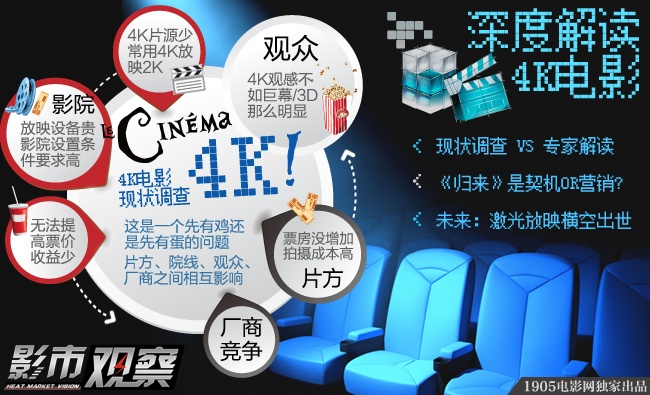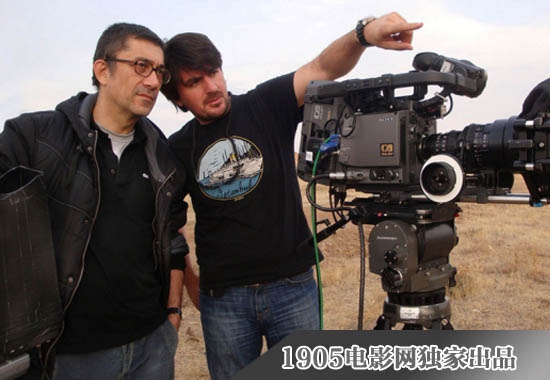
Special feature of 1905 film network The literary giant directed by Zhang Yimou has been shown in cinemas all over the country for some time, and made a special exhibition at the 67th Cannes International Film Festival. As the first film shot by a 4K camera, post-produced in 4K and released and shown in 4K in China, it can be said that Return fills the gap in domestic 4K movies. At the same time as the film was released, the concept of "4K", which is unfamiliar to most people, suddenly became hot. So what is a 4K movie? What is the current situation of 4K movies in the domestic market?
The so-called 4K actually refers not only to technology, but also to a brand-new movie-watching experience, which is simply "higher, faster and better". "Higher" refers to movies with ultra-high definition quality, and the resolution of 4K digital movie pictures is 4096*2160. At present, the resolution of 2K projectors used by most cinemas in China can only reach 2048*1080. For ordinary viewers, the gap between them is equivalent to the gap between Blu-ray and DVD.
"Faster" means higher frame rate. Because human eyes are less sensitive to high-speed motion, if you want to have the impression of ultra-high-definition movies when watching dynamic pictures, the movie pictures played per second must be increased from the current 24 frames per second to 60 frames. And "better" mainly means the promotion of the brightness and color of the film. Because the brightness of the 4K film is four times that of the 2K film, the details in the dark part of the picture are clearer, and the overall layering of the picture is strengthened, which can bring a more realistic viewing experience.


Hibernation, filmed with a 4K camera, won the Palme d ‘Or at the 67th Cannes Film Festival.
Coincidentally, at the just-concluded 67th Cannes International Film Festival in France, Popular Desire, directed by the master Ceylon, won the Best Film Palme d ‘Or Award, which was also shot with a 4K camera. However, in an interview with the media, the director modestly revealed that he only shot in 4K with sponsorship, without any consideration from the perspective of film aesthetics — — The caution of film creators is actually closely related to the status quo of the entire 4K industrial chain.
According to Xu Bin, the product strategy manager of China Film Barco, which was the first to sell and invest in 4K equipment in China, 4K technology and equipment are available now, but there are still difficulties in promotion: "This is actually a question of chicken or egg first."
4K resolution can bring a better viewing experience to the audience, but it has encountered many difficulties in marketing. Due to the high equipment cost and the limitation of cinema hardware conditions, at present, only more than 600 cinemas in China have 4K projectors. The bottleneck of the downstream industry directly affects the development strategy of filmmakers: according to statistics, in 2012, the number of films shot by 4K cameras in the global film market was single digits, and in 2013, this number increased slightly to more than 20.
The producer’s caution is not unreasonable. The shooting cost of a 4K movie is 150% of that of an ordinary 2K movie. In the post-production process, you must also use a projector with 4K resolution to color and repair the film. In order to show movies on the largest scale, publishers must also make two sets of digital copies, 2K and 4K. High investment in the whole industry chain can not bring high returns. This contradiction makes the promotion of 4K movies difficult.

In an exclusive interview with [1905 Movie Network], Xu Bin said that the movie screen with 4K resolution is playing on the screen, and ordinary viewers can’t see the difference between 4K and 2K with naked eyes. This is because the biggest difference between 4K resolution and 2K resolution is only the reduction of picture particles, just like a film with low resolution, once the audience sits far away from the screen, they think the picture is very clear.
In this way, the ordinary audience’s perceptual knowledge of 4K movies is not as strong as 2D to 3D and ordinary screen to IMAX from the beginning. This brings a problem to the cinema: if a 4K projector is purchased, the audience can’t recognize the improvement of picture clarity with their naked eyes, and the equipment funds can’t be recovered by raising the ticket price. For cinemas with box office revenue as the highest interest, 4K projectors are similar to "chicken ribs".

Of course, for those cinemas that pursue the audience’s viewing experience, 4K projectors can be regarded as a long-term investment. Orange Sky Jiahe Cinema and Jinyi Cinema are the first commercial cinemas in China to purchase 4K projectors. Among them, Jiahe Cinema has purchased hundreds of 4K projectors since it signed a strategic agreement with Sony in 2011. At present, 40% cinemas in Jiahe Cinema in China are equipped with 4K projectors. Due to the lack of film sources, Jiahe Cinema has been playing movies with 2K resolution with 4K projectors for many years.

Dr. Xie Qiusheng, Chief Technology Officer of Orange Sky Jiahe Group, explains 4K projection technology.
According to Dr. Xie Qiusheng, Chief Technology Officer of Orange Sky Jiahe Group, 4K projectors have a high demand for cinema hardware. Only on the big screen with a width of 16 meters to 25 meters can 4K movies show its delicate picture texture. At present, the screen with a width of 10-13 meters is the mainstream of domestic cinemas. From a technical point of view, giant screen is most suitable for showing the ultra-clear picture quality of 4K movies, but the number of giant screens is still very small.
At the same time, Xu Bin also talked about the requirements of cinema hardware. The equipment with 4K resolution is different from ordinary 2D projection equipment, and the seats in the whole cinema need to be readjusted. The audience sitting in the front can feel the clarity and texture of the picture. The extra expenses for the renovation of cinemas have also discouraged some cinemas from 4 K.

The high cost of 4K movies leads to the slow development of the whole industrial chain. According to reports, the film and television equipment suppliers represented by Sony, Barco and Secco have already introduced projection equipment with 4K resolution, but the sales volume of 4K projection equipment is far less than that of 2K equipment. In this regard, suppliers seem helpless. As a passive party in sales, equipment suppliers will provide technical support for cinemas from a long-term perspective-but cinemas can only choose and purchase projection equipment according to the ratio of return on investment and the cycle of capital recovery.
In addition, due to technology monopoly, the film projection technology is in the hands of a few companies, and the projection level is promoted through exclusive cooperation between exhibitors and suppliers, but for the audience, it has long been confused by new words such as IMAX, DMAX, Real 3D, RealD 6FL, Panorama Auditorium and so on. Why can’t all advanced technologies be organically combined with one projection equipment? The cooperation between manufacturers may accelerate the progress of projection technology. In recent years, the world’s top film and television equipment manufacturers have begun to work together. According to Xu Bin, IMAX and Barco signed an exclusive commercial cooperation agreement. In the next seven years, Barco will provide IMAX with laser projection equipment with 4K resolution, and it will not be a problem to watch 4K on the giant screen in the future.
Next page "Return": Is the opportunity of popularization of 4K screening still a marketing gimmick?
关于作者